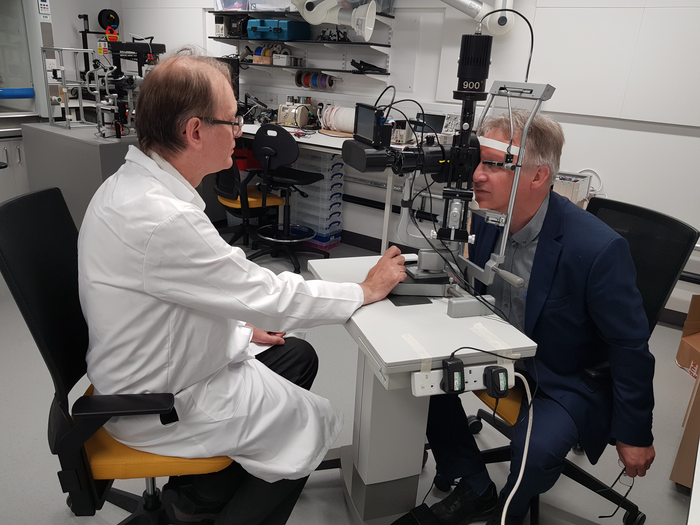Article
Pioneering device can take 3D images to detect eye diseases
Author(s):
Researchers at the University of Strathclyde have developed an affordable device which takes 3D images and could shift the landscape of eye screening and treatment around the world.
Mario Giardini, PhD, from the University of Strathclyde tests the technology developed at the University of Strathclyde in Glasgow, Scotland. Image courtesy of University of Strathclyde

An affordable device which takes 3D images could shift the landscape of eye screening and treatment around the world.
The device, developed by researchers from the University of Strathclyde in Glasgow, Scotland, captures 3-D images of the retina, the back of the eye and cornea, and can be added at low cost to a slit lamp, a device commonly used by ophthalmologists.
According to the university, patients diagnosed with conditions including glaucoma, which affects an 7.7 million people, and ophthalmologists typically make the diagnosis after looking at images and offering a subjective opinion on the 3D structure of the back of the eye.
While there currently are existing instruments for 3D imaging, including optical coherence tomography (OCT) technology – the machines can cost up to $100,000, often making them too expensive for large-scale population use, especially in low-income countries.
The university noted that the new technology is a simple and inexpensive add-on to a standard lamp, and can extend 3D eye imaging to all settings where ophthalmologists are present.
It is so simple that a modified version of the technology brings potential of 3D retinal “selfies” without an operator, meaning it could also be deployed in unassisted settings, like pharmacies.
The technology can also be used to image the front of the eye, which is important for cornea transplant patients as many machines cannot measure the edge of the cornea.
The device has been developed by Mario Giardini, PhD, Ian Coghill, PhD, and Kirsty Jordan, at the Department of Biomedical Engineering of the University of Strathclyde.
“Patients can be imaged easily and inexpensively, without the need for a specialist to be present,” Giardini said. “Our device reliably takes 3D images, and it is comfortable and fast, at less than a second.”
According to Giardini, the technology could revolutionize the screening and follow-up within the community of conditions such as glaucoma, as any ophthalmologist anywhere in the world could afford it.
“This work makes eye diagnostics more accessible, reducing inequalities,” he said.
Iain Livingstone, MD, a consultant ophthalmologist at NHS Forth Valley in Central Scotland, has collaborated with Giardini on previous ophthalmology projects, and pointed out that much of what ophthalmologists do hinges upon being able to see things in 3D.
“While photographs can be helpful, this innovation uses visible light to re-create a high fidelity 3D representation of eye structures, allowing precise measurements to be taken in a completely new way, piggybacking on the method of examination we already do routinely,” Livingstone said.
Moreover, Livingstone noted that the technology can be seen as a crucial addition to the way ophthalmologists interpret information, harnessing digital to glean so much more from a slit lamp exam, with potential reach far beyond the office setting.
The research team also noted that the technology could be used to detect ocular cancer, and Livingstone noted that “this addition turns a slit lamp into a ‘3D eye scanner’ with potential to supplant ocular ultrasound for measuring solid tumors of the eye.”
The initial prototyping was funded by the Engineering and Physics Research Council, part of UK Research & Innovation. The next step is now to make the technology available to the medical community, and the university has partnered with IDCP, a digital innovation group, to turn it into a medical product.
“Working with the University of Strathclyde to develop new technology for eye screening has been very productive, and this development will be a significant step for enabling more accurate, accessible, and cost-effective solutions to eye diagnostics globally,” Jan Boers, CEO of IDCP Group, said in a statement. “This is a great addition to our activities in the field of eye screening with RetinaScope and IDCP Scotland.”
Jamie Thomson, who managing director of IDCP Scotland, who received support from Scotland’s national economic development agency Scottish Enterprise, with a SMART grant of about $85,000, is excited about the prospects of the new technology.
“As a University of Strathclyde alumnus, it gives me great pride to be working closely with the team helping to develop this technology, which has the potential to improve the quality of patient care and fits within IDCP Scotland’s key objective to revolutionize patient care within ophthalmology,” Thomson said in a statement.
Newsletter
Don’t miss out—get Ophthalmology Times updates on the latest clinical advancements and expert interviews, straight to your inbox.




